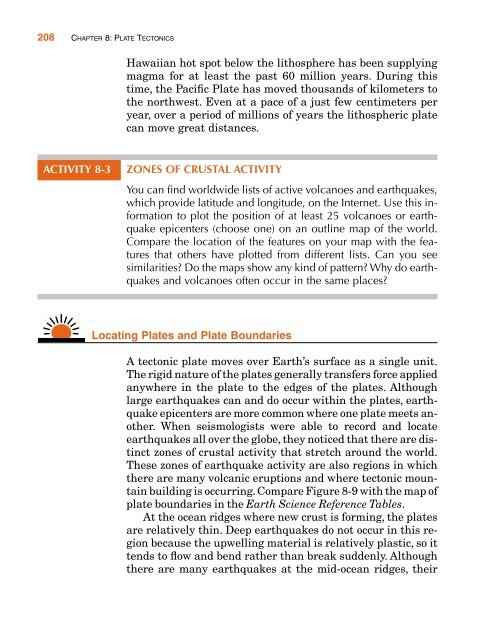Chapter 8 Plate Tectonics
Chapter 8 Plate Tectonics
Chapter 8 Plate Tectonics
You also want an ePaper? Increase the reach of your titles
YUMPU automatically turns print PDFs into web optimized ePapers that Google loves.
208 CHAPTER 8: PLATE TECTONICS<br />
Hawaiian hot spot below the lithosphere has been supplying<br />
magma for at least the past 60 million years. During this<br />
time, the Pacific <strong>Plate</strong> has moved thousands of kilometers to<br />
the northwest. Even at a pace of a just few centimeters per<br />
year, over a period of millions of years the lithospheric plate<br />
can move great distances.<br />
ACTIVITY 8-3 ZONES OF CRUSTAL ACTIVITY<br />
You can find worldwide lists of active volcanoes and earthquakes,<br />
which provide latitude and longitude, on the Internet. Use this information<br />
to plot the position of at least 25 volcanoes or earthquake<br />
epicenters (choose one) on an outline map of the world.<br />
Compare the location of the features on your map with the features<br />
that others have plotted from different lists. Can you see<br />
similarities? Do the maps show any kind of pattern? Why do earthquakes<br />
and volcanoes often occur in the same places?<br />
Locating <strong>Plate</strong>s and <strong>Plate</strong> Boundaries<br />
A tectonic plate moves over Earth’s surface as a single unit.<br />
The rigid nature of the plates generally transfers force applied<br />
anywhere in the plate to the edges of the plates. Although<br />
large earthquakes can and do occur within the plates, earthquake<br />
epicenters are more common where one plate meets another.<br />
When seismologists were able to record and locate<br />
earthquakes all over the globe, they noticed that there are distinct<br />
zones of crustal activity that stretch around the world.<br />
These zones of earthquake activity are also regions in which<br />
there are many volcanic eruptions and where tectonic mountain<br />
building is occurring. Compare Figure 8-9 with the map of<br />
plate boundaries in the Earth Science Reference Tables.<br />
At the ocean ridges where new crust is forming, the plates<br />
are relatively thin. Deep earthquakes do not occur in this region<br />
because the upwelling material is relatively plastic, so it<br />
tends to flow and bend rather than break suddenly. Although<br />
there are many earthquakes at the mid-ocean ridges, their
















